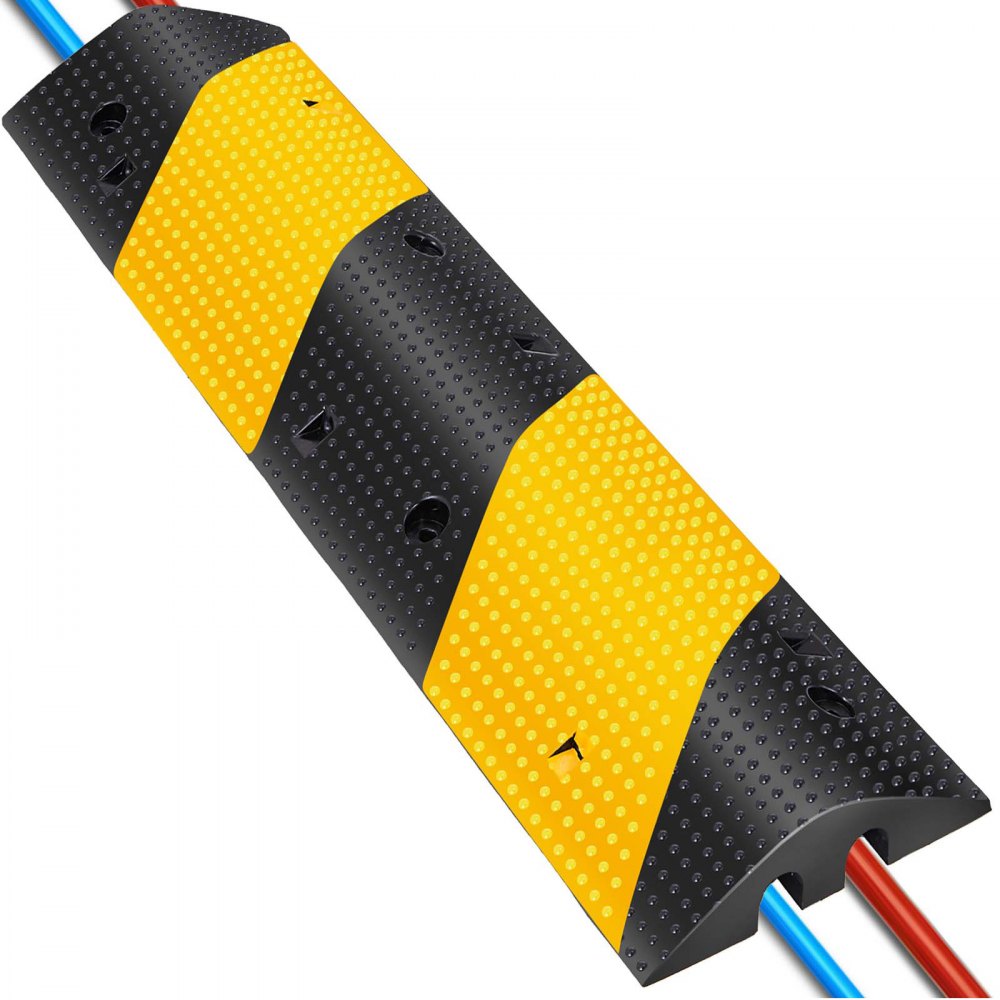Rubber Speed Bumps for Driveway: A Comprehensive Guide to Safety and Durability

Speed bumps are essential for controlling vehicle speed and enhancing safety, especially in residential and commercial driveways where vehicles frequently enter and exit at high speeds. Rubber speed bumps are an increasingly popular choice for driveway installations, offering a host of advantages over traditional concrete or metal speed bumps. Known for their durability, impact absorption, and ease of installation, rubber speed bumps are designed to withstand both regular vehicle traffic and extreme weather, making them ideal for driveway use.
In this article, we’ll explore the benefits of rubber speed bumps for driveway, their applications, installation process, maintenance, and considerations for choosing the right product.
Why Choose Rubber Speed Bumps for Driveway?
Rubber speed bumps are ideal for driveways for a variety of reasons, including durability, ease of installation, and long-lasting performance. They are particularly effective in driveways where frequent vehicle traffic can lead to speed-related safety concerns for residents, pedestrians, and pets.
Key Benefits of Rubber Speed Bumps for Driveways
- Durability and Weather Resistance
- Made from high-quality, vulcanized rubber, these speed bumps are built to endure extreme temperatures, heavy rainfall, snow, and UV rays. Unlike concrete, which may crack or degrade over time, rubber speed bumps retain their integrity for years, making them suitable for long-term driveway use.
- Gentle on Vehicles
- Rubber speed bumps are designed to absorb impact rather than resist it entirely, providing a smoother experience for vehicles driving over them. This is beneficial for driveway speed bumps, as residents may drive over them frequently. Rubber bumps are gentle on tires, suspensions, and vehicle frames, reducing wear and tear.
- Simple Installation and Removal
- Rubber speed bumps are easy to install on various surfaces, including concrete, asphalt, and even gravel, making them versatile for most driveway types. They are often modular, with pre-drilled holes that make anchoring quick and simple. Additionally, they can be unbolted and removed if no longer needed, providing flexibility not found in permanent concrete installations.
- Environmentally Friendly
- Many rubber speed bumps are made from recycled materials, such as used tires. By choosing rubber speed bumps, homeowners are supporting eco-friendly practices and helping reduce waste.
- High Visibility for Safety
- Most rubber speed bumps come with reflective strips or bright yellow markings, ensuring they are visible in all lighting conditions. This visibility is essential for driveways, particularly at night or in poor weather, to prevent accidental trips and falls.
Applications of Rubber Speed Bumps in Driveways
Rubber speed bumps are suitable for a variety of residential and commercial driveway settings, including:
- Residential Homes: For families with children or pets, rubber speed bumps encourage slower speeds in driveways, reducing the risk of accidents.
- Apartment Complexes: Rubber speed bumps help control speed within multi-family properties, ensuring residents’ safety and protecting parked vehicles.
- Schools and Daycare Centers: For driveways leading to schools or daycare centers, rubber speed bumps provide an added layer of safety for children during drop-off and pick-up times.
- Commercial Driveways and Parking Lots: Businesses with driveways or parking access can use rubber speed bumps to maintain a controlled flow of traffic and prevent accidents.
- Private Roads: Long, private driveways or shared roads benefit from speed control to improve safety for residents and visitors.
How to Choose the Right Rubber Speed Bump for Your Driveway
Selecting the right rubber speed bump involves considering several factors to ensure it meets your driveway’s needs:
- Size and Height
- Rubber speed bumps come in various lengths, widths, and heights. For residential driveways, a lower-profile speed bump (around 2 to 3 inches in height) is typically ideal, as it slows traffic without creating a jarring experience.
- Reflective Markings
- Ensure the rubber speed bump has reflective stripes or embedded yellow or orange strips. This improves visibility at night, preventing potential accidents or vehicle damage.
- Load Capacity
- Look for speed bumps with a high load capacity if your driveway regularly supports heavier vehicles like delivery trucks. Most rubber speed bumps are designed to handle at least 20,000 pounds, making them suitable for standard vehicles and light commercial trucks.
- Anchoring Options
- Check the anchoring options provided with the speed bump. Most rubber speed bumps come with pre-drilled holes and mounting hardware for easy installation on asphalt or concrete. For gravel or other loose surfaces, consider additional anchoring solutions.
- Modular Design
- Some rubber speed bumps are modular, allowing you to connect multiple sections for longer driveways. This modularity is useful if you need speed bumps for an extended area or a wide driveway.
Installation Process for Rubber Speed Bumps in Driveways
Installing rubber speed bumps on a driveway is a straightforward process and can often be done with basic tools. Here is a step-by-step guide:
- Plan the Placement:
- Identify the areas where speed control is necessary, typically closer to the driveway entrance or near pedestrian pathways. Ensure that the location chosen will be visible to approaching vehicles.
- Prepare the Surface:
- Clean the surface where the speed bump will be installed, removing dirt, oil, or other debris. This ensures the adhesive or bolts secure the bump properly.
- Position the Speed Bump:
- Lay out the rubber speed bump in the intended location. Align it so that it sits flush with the driveway surface.
- Anchor the Speed Bump:
- Use the provided bolts or screws to anchor the speed bump in place. Typically, this involves drilling holes into the driveway surface and then securing the speed bump with the bolts.
- Check Stability:
- Ensure that the speed bump is securely fastened and does not shift when driven over. This will prevent the bump from moving out of place or becoming a tripping hazard.
Maintenance of Rubber Speed Bumps on Driveways
One of the significant advantages of rubber speed bumps is their low maintenance requirements. However, a few steps will help extend their lifespan:
- Regular Cleaning:
- Clean the rubber speed bump periodically to remove dust, debris, or oil buildup. A simple hose-down or a wipe with soapy water is usually sufficient.
- Inspect for Wear and Tear:
- Check for signs of wear, especially in high-traffic driveways. If reflective markings fade, consider repainting them or applying new reflective tape.
- Check Anchors:
- Over time, the bolts or screws anchoring the speed bump may loosen due to vehicle impact. Periodically check and tighten them as necessary.
- Winter Maintenance:
- During winter, clear snow and ice around the speed bump to prevent ice buildup, which can reduce visibility and increase slippage.
Advantages of Using Rubber Speed Bumps over Other Materials
Rubber speed bumps offer unique benefits compared to other materials commonly used for speed bumps, such as concrete or plastic:
- Flexibility and Impact Absorption: Rubber compresses slightly under pressure, reducing impact on vehicles and the driveway itself, whereas concrete may crack.
- Eco-Friendly Option: Often made from recycled rubber, these speed bumps are a more environmentally sustainable choice.
- Weather-Resistant: Rubber is naturally resistant to weather conditions that may degrade other materials, such as snow, heat, and rain.
- Easy to Relocate: Rubber speed bumps can be unbolted and moved if driveway layouts or needs change.
Conclusion
Rubber speed bumps are an excellent choice for driveways due to their durability, impact absorption, and ease of installation. Ideal for both residential and commercial settings, rubber speed bumps provide effective speed control while remaining gentle on vehicles and resilient in all weather conditions. By choosing rubber speed bumps, property owners can improve safety, protect vehicles, and contribute to eco-friendly practices.
Whether you need to enhance safety in a home driveway or control vehicle speed in a business parking lot, rubber speed bumps offer a cost-effective, long-lasting solution for any driveway application.







